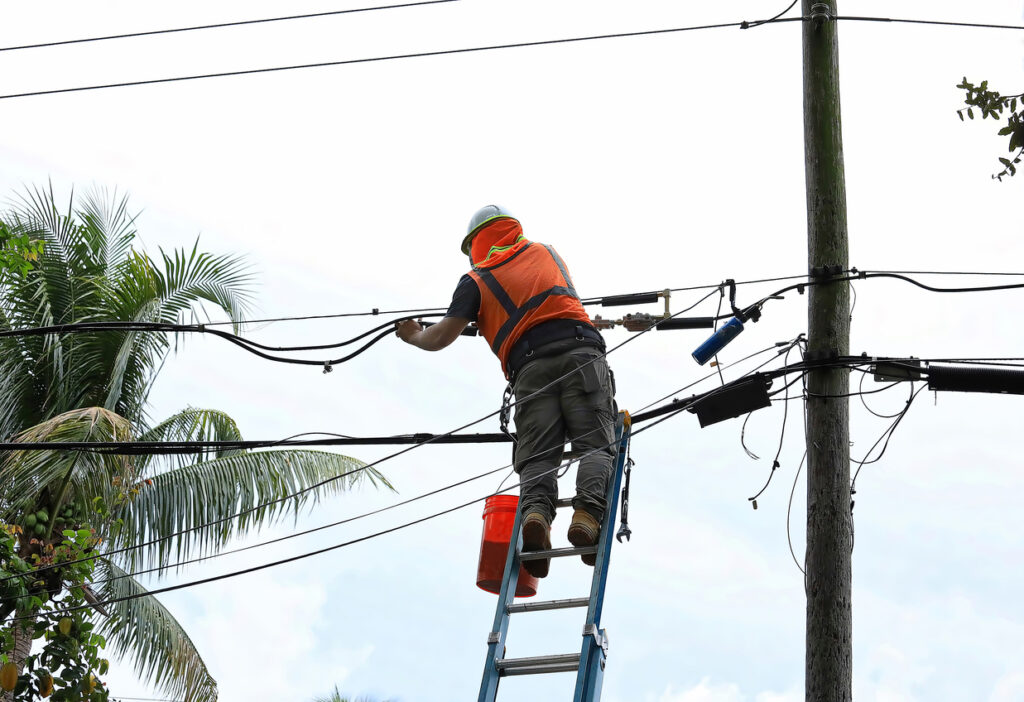Adapting to extremes: How communicators in the energy industry save lives
Amid boiling summers and a roiling storm seasons, comms can have life-or-death implications for outdoor workers.

As an unusually hot summer clings to many regions across the globe and hurricane season churns on, extreme heat, poor air quality and sudden storms pose hazards to not only residents but those who work outdoors — requiring their employers to be a communications conduit and a source of support.
In these conditions, working outdoors can become life-threatening without the proper resources, policies and support from employers. On top of that, line workers for energy and power providers have received threats in recent months from the very public they’re employed to help.
We spoke with Michelle Delery, director of corporate internal and external communications at Entergy Corporation, and Kim Selph, director of digital customer experience, communications and marketing for Tampa Electric, about the evolving challenges of keeping both personnel and consumers safe, informed and connected.
Simplifying and quantifying messages for frontline workers
Reaching deskless workers is a chronic challenge for communicators across a variety of industries, but is especially important for frontline energy employees. Entergy’s methods for alerting employees of climate conditions have evolved in recent years, expanding to include more multimedia across every available channel — digital signage, employee apps, email, and especially in-person communications from on-site leadership.
“We work with the business to make sure our outdoor safety messages are easy to understand and follow,” Delery said. “And of course, we ensure that they are being updated as the environment changes.”
And although conditions can be more volatile than they were in decades past, communicators have access to more robust, real-time data — weather apps, air quality alerts and tracking technology — which didn’t exist five or ten years ago.
“We have access to information today that we might not have been able to capture years ago,” explained Delery. “In the past, general weather advisories were often sufficient, but now, real-time information and adaptability are crucial to meet our stakeholders’ expectations.”
During the last hurricane, Tampa Electric relied on its employee app, an intranet homepage takeover dedicated to the storm, and regular email updates. “Leaders also received regular, updated talking points which aligned with our messaging for that day, to ensure every based was covered,” Selph said.
Her team makes a point of getting in the field to better understand workers, their mindset and the challenges they face through direct conversation and connection.
“Many communications people work in a corporate office and sometimes have little interaction in the field,” Selph explained. “It’s important to get out there and understand their realities and identify the channels that work best for them. They often get a lot of their information from in-person meetings and communicate with their cell phones. You should keep this in mind when communicating this important information.”
Perfecting policies
Policies must change to keep pace with new climate realities. Delery points to Entergy’s “Work/Rest/Hydration” schedules, which include reminders about staying cool by removing PPE and extra clothing during breaks and spending time in air-conditioned break areas.
That sometimes means working around egos in favor of safety. “We are always cognizant that front-line employees may be overly confident in their ability to manage the heat,” Delery said..
But it’s not just the heat. “Air quality is a more prominent concern today than it was 10 years ago,” continued Delery, citing wildfires and pollution as threats to communities and employees. “Companies now need to incorporate air quality advisories and provide protection against harmful pollutants in addition to heat protection.”
Selph echoes the need for preemptive communication. “We anticipate scenarios in advance, with pre-established language and approval processes to ensure rapid action when needed. Every hurricane season, we prepare templates with before, during, and after-storm messaging for stakeholders, updating them annually to keep them fresh and ready for deployment,” she said.
Nailing the timing
Both Delery and Selph agree that there’s no room for delay when it comes to safety messaging.
To get the right message to the right people — at the right time and in the right way — Tampa Electric works ahead of any disaster warnings through scenario planning, developing pre-established language that can be adapted and deployed quickly, and streamlining approval processes to avoid last-minute revisions.
“For tropical systems, we maintain a set of four scenario-specific templates, which include before, during and after the storm messages for each set of stakeholders,” Selph said. “They are mostly pre-written with segments that can be tailored to the unique situation. We ensure these templates are updated and reviewed annually before the storm season begins to guarantee they are ready for deployment.”
When a storm strikes, a single executive is the “incident commander” responsible for final approvals.
Similarly, Entergy regularly runs tests of its communications response plans to ensure they’re updated. However, “it’s important to remind everyone that safety trumps speed when communicating about hot weather and storm risks,” Delery said. “Nothing is more important than ensuring that our employees, contractors and customers remain safe.”
Know your options and find your allies
Selph advises communicators working in industries that hinge on weather and climate conditions to have a range of options for receiving information, matching those preferences, and ensuring that everyone knows the best place to find the most accurate, up-to-date messages.
“Know your consumers’ preference in terms of whether they’d like to receive a text, email or voicemail and communicate to them in their preferred method,” she said. “For employees, ensure they know what channel should be considered their ’single source of truth’ and have back-up communication methods available for senior leadership in case connectivity is lost due to severe weather.”
One of the best ways to ensure cohesive messaging within a given community is to build a close relationship with emergency management officials and other important partners so information is shared consistently, cohesively and collaboratively. “You want to have these contracts in your phone and to know them prior to the emergency occurring,” said Selph
But don’t try to do it all yourself. After all, an entire community leaps into action when a storm or urgent weather condition arises. “Ensure you stay focused on your lane, which for us includes weather-related incidents that involve electricity,” Selph said. “For example, what to do if you encounter a downed line, how floodwaters can hide downed lines and when and how to safely use generators.”
Her team also works with the government to ensure they have official messaging and resources on hand — even for unexpected occurrences such as scammers who target customers during and after crises.
ESG evolved
For energy companies, environmental, social and governance (ESG) work isn’t a hope or a vague pledge. Their future and the lives of many of their customers relies on the ability to deliver power to communities experiencing unpredictable climate and weather conditions. And in many regions, aging energy infrastructure has strained these companies’ capabilities in recent years.
As a result, Entergy’s ESG policies have shifted to focus on infrastructure resilience. “It’s more important now than ever to strengthen and modernize the U.S. power grid as severe weather events become more frequent,” Delery said. “Accelerating resiliency investments will allow us to respond better to each storm and ensure our customers have not only reliable but affordable power.”
Entergy is aiming for net-zero greenhouse gas emissions by 2050. To keep up with its goals, Delery emphasizes the need for strong corporate governance systems that emphasize ethics, transparency and accountability. “We’ve seen the focus on governance practices continue to grow in recent years,” Delery said. “Good governance measures help businesses manage risks and opportunities.”
Learn more about how communicators are evolving their practices to build resiliency and prepare for the future at Ragan and PR Daily’s 2024 Future of Communications Conference in Austin, Tex., Nov. 12-15.






